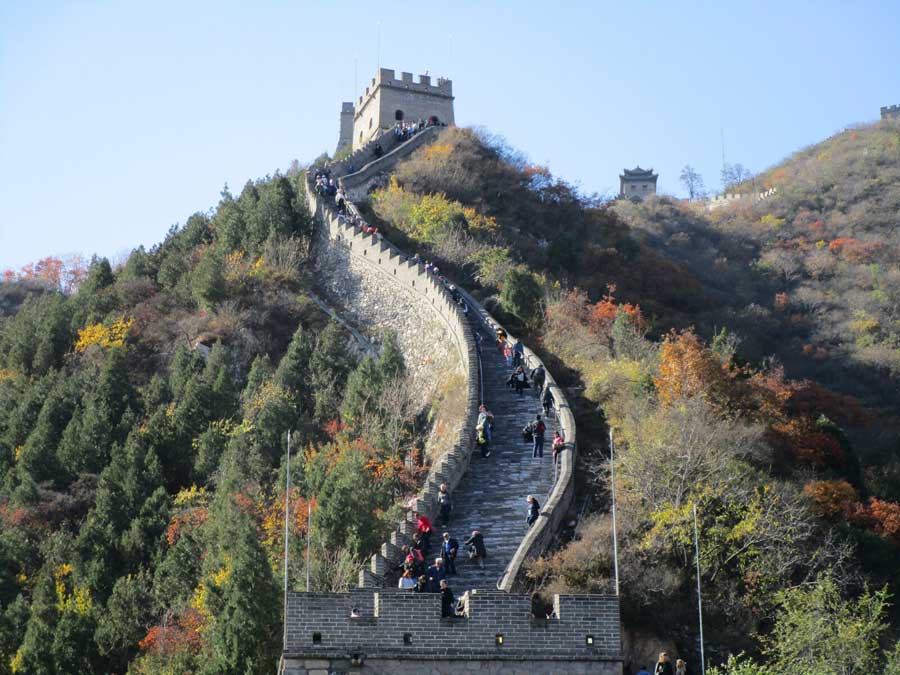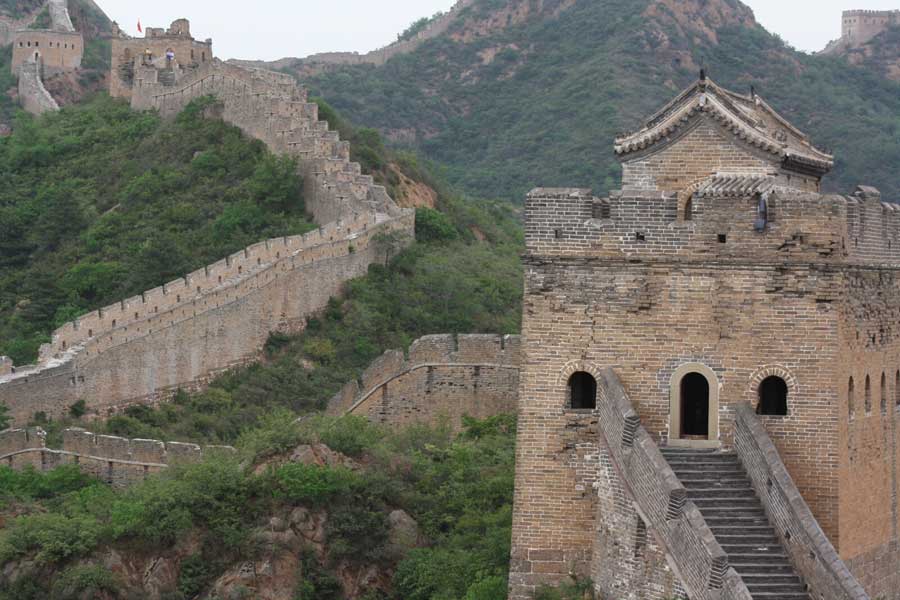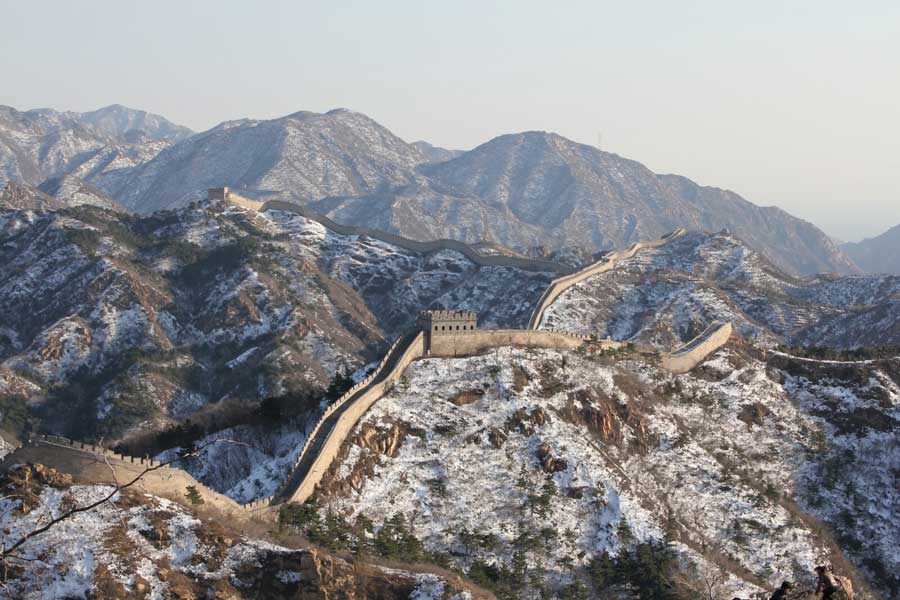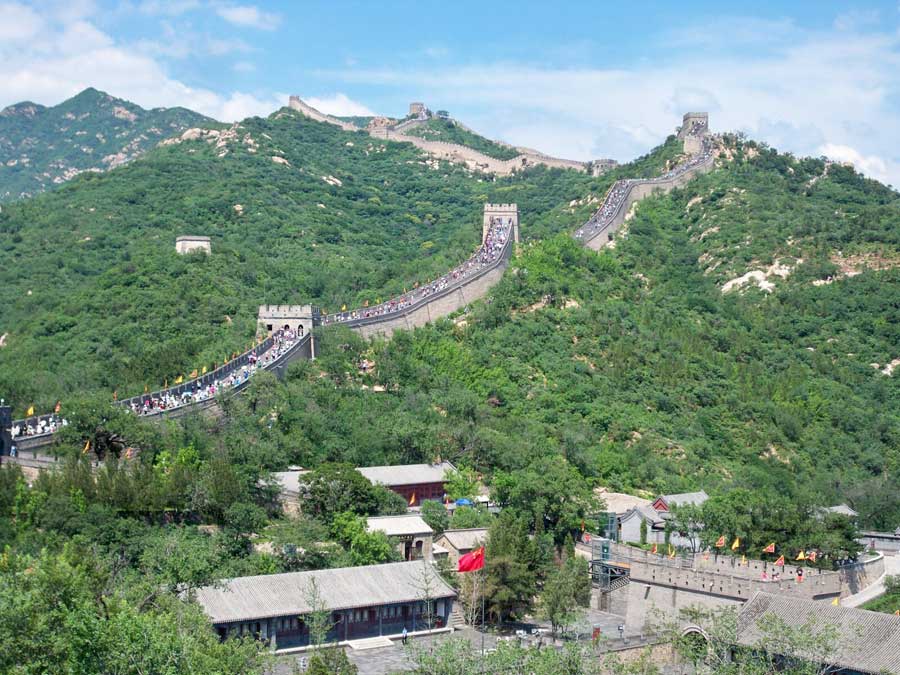10 Fun And Interesting Facts About The Great Wall Of China

The Great Wall of China is one of those feats of human vision, power, and technology that we find utterly amazing. It is a cultural icon that spans centuries of religious, political, and social belief systems. Like the great Pyramids of Egypt, the Taj Mahal of India, and Barabadour of Indonesia, the Great Wall of China inspires both curiosity and awe of ancient man…
The Great Wall Of China Facts
The Great Wall of China took over 2,000 years to create and is the result of various ruling warlords and emperors beginning as far back as the Seventh Century BC. It is primarily an east to west separation aiming to protect the northern territories of China from the southern areas and from Mongolia. During different periods of rule however, off-shoot branches were also erected in other directions. When we refer to the Great Wall of China, it is the expansive east-west length of wall that is indicated.

Where Does The Name, “The Great Wall”, Come From?
An interesting fact on the Great Wall: the name, The Great Wall, is derived from the Chinese name, ‘the great number of li-long wall‘ which literally means 10,000 li, or approximately 5,000 kilometers. This was eventually shortened to simply “The Great Wall”.
Another commonly asked question regarding the Great Wall – how long is it? The answer is in fact quite complex, and requires us to delve deeper into the history of the Wall…
How Long Is The Great Wall Of China?
The reference to 10,000 li mentioned above (or close to 5,000 kilometers (3,100 miles)) is in itself an interesting fact that stirs up questions and controversy because it is not possible to get an actual measurement of the length of the Great Wall of China due to its continual evolution and erosion and the many different branches and natural borders. When the Chinese named this structure “the great number of li-long wall”, parts were already very old and no longer in use. They didn’t actually know the precise length, so the term 10,000 li was used hypothetically, not literally.

Building The Great Wall…Combining The Pieces
Historians actively seek the facts surrounding the history of the Great Wall. Determining its true length has proved more difficult than anyone would have imagined. Various sections of the Great Wall were built by different leaders throughout China’s long dynastic history. New leaders emerged and made additions; civilizations changed and moved so they no longer needed other parts, some of which were eventually left to decay.
This brings us back to the question of The Great Wall’s length. There were man-made trenches and natural barriers such as mountains, rivers, and lakes that were included in the wall as well. There were also many side branches that veer off from the main east to west portion that is considered the primary length.
Therefore, historians and geographers continue to debate the most authentic definition of the Great Wall of China and are unable to calculate an actual total length. It is estimated, however, that if all the fortified walls ever built were added together, it would be more than 50,000 kilometers (31,000 miles) in length. This is truly amazing when we consider the fact that the earth’s circumference is 24,000 miles!
When Was The Wall First Built? And Who Built It?
Another sought after fact is the date of origin of the great wall. It is believed that the first parts of the Great Wall of China were built-in the Seventh Century BC, directed and funded by regional princes and overlords to defend regional borders. At that time, China was made up of warring feudal clans and the wall served to separate and protect. These first sections were made with rammed earth, adobe, and stone, all materials that steadily eroded over time. As a result, many parts of the first sections have been lost.
Beginning with the Ming Dynasty (1368 – 1644) the builders added bricks to their materials which made the wall stronger. Nonetheless, many parts of the wall built during the Ming Dynasty are no more than impressive remains today. Other parts of this portion however, are today’s great tourist attractions.

This portion of the Great Wall was built near modern-day Beijing and is now the most commonly visited section of the wall. In fact, this section of the wall was the first to ever be opened to tourists in 1957. This is also the place visited by US President Richard Nixon in 1972.
Beginning in the Second Century BC, the Qin Dynasty emerged and established a unification of many smaller states in northern China. This marked the transition from many smaller warring states to the great dynastic period in Chinese history. China’s first emperor, Qin Shihuang (thus the name Qin for the Dynastic period), linked the walls of three separate northern states. His purpose was to form a unified line of defense from Mongolian invasion. Under his direction and with the three walls expanded into one “great” wall, the fortress was first named “The Great Number of Li-Long Wall”.
Under the rule of the Han Dynasty (206 BC – 220 AD) the wall grew to its greatest length. Estimates record the full length at that time to be more than 8,000 kilometers (5,000 miles) long. The wall underwent another period of great expansion during the Ming Dynasty (1368 – 1644).
What Was The Original Purpose Of The Great Wall?
As the primary purpose of the Great Wall has always been military strength and defense, it is no surprise to learn that the human sacrifice in building the wall was tremendous. In fact, one of the nicknames for the Great Wall of China is “the longest cemetery on earth” because so many lives were spent in the building of The Great Wall. It is estimated that over one million people lost their lives to the construction of The Great Wall. It is not true however, that human bones were used as building materials. This is one of the many myths that make up the Great Wall legends.
There are various forts, storage buildings, beacon towers and military housing units along the Great Wall of China. As these were also built during various periods of Chinese history and under the direction of different emperors, these structures represent a survey of the history of Chinese architecture.
What Is The Wall Used For Today?
The last battle to be fought at The Great Wall was during the Sino-Japanese war in 1938. Visitors today can still see bullet marks in the wall that runs along Gubeikou. Since then, the focus of the Great Wall of China has been preservation and protection.
In the 20th Century the Great Wall has suffered destruction by rapid erosion and the activities of local people, visitors, and developers. In 1987 UNESCO (the United Nations Educational, Scientific and Cultural Organization) placed the Great Wall on its list of the world’s great national and historical sites. This opened many doors for funding and legal protection orders.

Many efforts are being made by the Chinese government and the global community to preserve and protect the Great Wall of China. The longest man-made structure in the world, the Great Wall of China also holds the record for consuming the longest duration and the greatest cost in human lives.
Chairman Mao Tsu Tung, the Chinese leader who opened China to the Western world with President Nixon’s legendary visit, said that “until you reach The Great Wall, you are no hero”. This sums up not only a Chinese virtue, but an inspiration to all of humanity meaning that you can not reach any goal until you overcome many difficulties.
Human Power, Endurance, And Sacrifice: A Treasure For All Humanity
The blood, sweat, and tears of millions of Chinese laborers speak to the world’s citizens today as we admire human power, endurance, and sacrifice. This great structure belongs to China, but is a treasure for all humanity as we learn to respect our collective past and treasure the relics that represent the lives of our ancestors.
A similar treasure can be found on the other side of the globe, but maybe not as visible to the human eye. Ever wonder if some of the Mayan’s ancient discoveries, such as their calendar, are in use today?





Over the years, there have been many battles and wars that were fought near the Wall. This includes a number of internal warring factions within China itself. There were also battles against the Mongols at various points. The last major battles fought anywhere near the wall were during the 1938 Sino Japanese War right before the start of World War 2.
Since this time, the Great Wall of China has become one the most well known tourist attractions in the world. UNESCO also placed the Wall on its list of the greatest historical sites in the world. Currently, many efforts are under way by the Chinese government to help preserve and protect what is currently the longest man made structure in the world.
Contrary to popular belief, you are not able to see the Great Wall of China from the moon, or even space. This is a common myth. In actuality, there are no man made structures that can be seen from the moon. In fact, many astronauts have stated that you can barely even make out the continents from so far away.
The Great Wall of China has always been a subject that fascinated me. This was true since my childhood. Having a look at some part of the wall in person is high on my list of things to do before I die. I suspect that many others have as similar aspiration.
One of the more intriguing facts I have discovered during my search for information about this wall is that it is not a single continuous fortification. While it does stretch for over 5,500 miles, it is really a collection of shorter walls. Sometimes these shorter walls connect, but there are many places which are not connected. They stretch more or less along the edge of the Mongolian plain.
The history and development of the Great Wall is also quite interesting. The Wall was first started during the Qin dynasty, which ruled from 221 to 206 BC. The original purpose of this wall was to keep out nomads from Mongolia. These original walls were built from earth and stones that were set in wooden frames. I wonder how effective they were at actually keeping the nomads out of China. My guess would be that their effectiveness was only moderate, since this led to additional period of building.
Some commentators have stated that the Wall reached its greatest length during the Han dynasty, which ruled from 206 BC to 220 AD. Of course, there were many additional building and fortification projects during the next thousand years or so.
Most of what we would consider to be the modern wall was begun with the Ming dynasty between 1388 and 1644. Much of these were established in new areas from the original walls built by the Qin originators. Under the Ming rule, the wall reached heights of 25 feet and widths of up to 30 feet at the base and 12 feet at the top.
These dimensions were perfect, since the main goals of the wall were fortification and defense in a military sense. Guard stations and watch towers were also established at regular intervals during this period.
The main problem with the Wall was that it was discontinuous. This fact allowed Mongol invaders no real trouble breaching the wall and entering China. This eventually led to the construction of the Wall being abandoned.
I have also heard it said that building this wall was quite expensive. This was true both in terms of money (materials) and men. It has been said that over one million lives were lost in the process of building the wall. Some writers have called it the longest cemetery on earth!
I agree that the great wall is infinitely cool. I have yet to see it in person however. I hope I’m able to collect the $ together one day to see this marvel of the world…